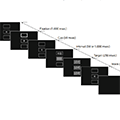Abstract
A Stroop task with separate color bar and color word stimuli was combined with an inhibition-of-return procedure to examine whether visual attention modulates color word processing. In Experiment 1, the color bar was presented at the cued location and the color word at the uncued location, or vice versa, with a 100- or 1,050-msec stimulus onset asynchrony (SOA) between cue and Stroop stimuli. In Experiment 2, on Stroop trials, the color bar was presented at a central fixated location and the color word at a cued or uncued location above or below the color bar. In both experiments, with a 100-msec SOA, the Stroop effect was numerically larger when the color word was displayed at the cued location than when it was displayed at the uncued location, but with the 1,050-msec SOA, this relation between Stroop effect magnitude and location was reversed. These results provide evidence that processing of the color word in the Stroop task is modulated by the location to which visual attention is directed.
